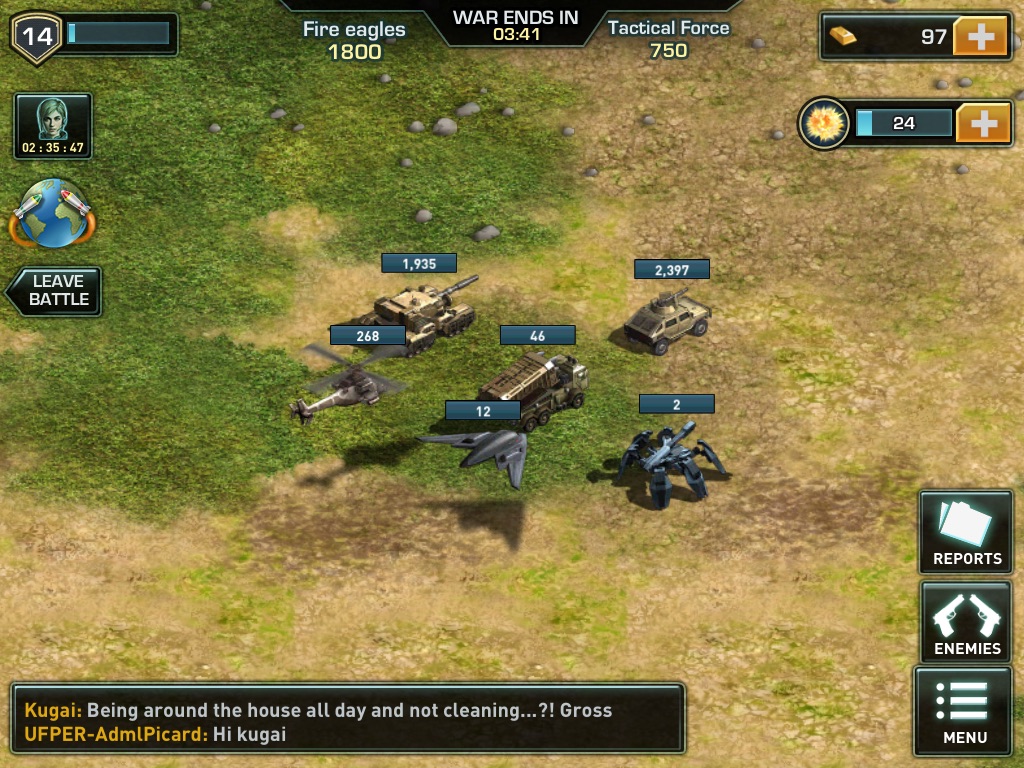Article II Section 2 of the U.S. Constitution, the Commander in Chief clause, states that '[t]he President shall be Commander in Chief of the Army and Navy of the United States, and of the Militia of the several States, when called into the actual Service of the United States.'
War of Nations for PC is a game that will let you feel as if you are really handling a group of soldiers, train them to battle and give commands. From the main menu, you can visit the store, inventory, alliance, reports, commanders, banking and your profile. 5 United Nations Command, “UN Command Observes United Nations Day,” United States Force Korea Press Releases, October 23, 2018. 6 'Hanbando jongjeonseon-eonhaedo yuensa yuji geunmuyowon 2bae isang neullil geos” Even after the end of the Korean peninsular war, the United Nations Command will be maintained. The number of servicemen will. List of Commanders. The command of ISAF has rotated between officers of the participating nations. The first American took command in February 2007 and only Americans have commanded ISAF since that time. The Korean War, often referred to as 'The Forgotten War,' was fought from June 25, 1950, to July 27, 1953. Commander-in-chief of Far East Command and commander-in-chief of United Nations. 10,416 likes 3 talking about this. Build a global military empire and crush your enemies in War of Nations! Battle other players, take over the world and become the most dominant.
The questions of whether and to what extent the President has the authority to use the military absent a Congressional declaration of war have proven to be sources of conflict and debate throughout American history. Some scholars believe the Commander in Chief Clause confers expansive powers on the President, but others argue that even if that is the case, the Constitution does not define precisely the extent of those powers. These scholars tend to construe the Clause narrowly, asserting that the Founders gave the President the title to preserve civilian supremacy over the military, not to provide additional powers outside of a Congressional authorization or declaration of war.
War Powers Resolution
After the Kennedy, Johnson, and Nixon Administrations spent nearly a decade committing U.S. troops to Southeast Asia without Congressional approval, in 1973 Congress responded by passing the War Powers Resolution. The Resolution sought to halt the erosion of Congress's ability to participate in war-making decisions, an aim furthered by the Resolution's requirement that the President communicate to Congress the commitment of troops within 48 hours. Further, the statute requires the President to remove all troops after 60 days if Congress has not granted an extension.
Presidents have typically considered the War Powers Resolution to be unconstitutional, and so they have tended not to follow it. This unwillingness has never been challenged by another actor (congress, civilians, etc), so the Supreme Court has never up the issue. In one way, the resolution takes an unprecedented action by allowing the President to unilaterally put American troops into conflict. Although the act imposes a check on the President (by imposing a limit for the amount of time the troops can be deployed without Congressional consent), the act has not appeared to pose any practical checks on Presidential actions.
And even though the War Powers Act exists, Congress is still largely deferential toward the President with regard to military authorization. For example in 1995, regarding the sending of US troops into Bosnia, Bob Dole (the Republican Senate Majority Leader) said that President Clinton (a Democrat) had “the authority and the power under the Constitution to do what he feels should be doneregardless of what Congress does.”
War Of Nations Commanders List Download
Commander in Chief Powers Post-9/11
The terrorist attacks of September 2001 created new complications for the separation of powers within the war powers sphere. After September 11, the United States Congress passed the Authorization for Use of Military Force against Terrorists (AUMF). While the AUMF did not officially declare war, the legislation provided the President with more authority upon which to exercise his constitutional powers as Commander in Chief. As the U.S. Supreme Court explained in Youngstown Sheet & Tube Co. v. Sawyer, Presidential Commander in Chief powers increase when Congressional intent supports the actions taken by the Commander in Chief. The AUMF served as that expression of Congressional intent.
AUMF authorizes the President to use “all necessary and appropriate force against those nations, organizations, or persons he determines planned, authorized, committeed, or aided in the Sept. 11 attacks.'
President George W. Bush, his cabinet, and his military advisers determined that the al-Qaeda terrorist network had financed and perpetrated the September 11 attacks. They also determined that the Taliban, a group in control of the Afghanistan government, had permitted al Qaeda to operate and train its members within Afghanistan's borders. Thus, the President used military force to invade the country in an effort to destroy the al-Qaeda network and topple the Taliban.
During the conflict, the U.S. military rounded up alleged members of the Taliban and others fighting against U.S. forces. The military then placed these 'detainees' at a U.S. base located at Guantanamo Bay, Cuba at the direction of the Bush Administration, which believed that the base fell outside the jurisdiction of U.S. federal courts. Consequently, the Bush Administration and military believed that the detainees could not avail themselves of habeas corpus and certain other protections guaranteed by the U.S. Constitution.
The military held many of these prisoners at the Guantanamo base for years without bringing formal charges against them. Prisoners obtained legal counsel in the U.S. to file habeas corpus petitions in U.S. federal court. A series of cases then came before the U.S. Supreme Court dealing with the constitutionality of the prisoners' detentions at Guantanamo.
The Supreme Court's Response to Treatment of Detainees
In 2004 Rasul v. Bush became the first case in which the Supreme Court directly discussed the Bush Administration's Guantanamo detention policies. 542 U.S. 466. The Court held that 28 U.S.C. § 2241 permits federal district courts to hear habeas corpus petitions by aliens held within territory over which the United States exercises 'plenary and exclusive jurisdiction.' This holding included Guantanamo detainees. The Court then instructed the district courts to hear the petitions.
After the Bush Administration responded to Rasul by permitting detainees to bring their petitions before military tribunals, the Supreme Court again addressed the matter in 2006 when they decided Hamdan v. Rumsfeld. 548 U.S. 557. The Court in Hamdan held that the President lacks constitutional authority under the Commander-in-Chief Clause to try detainees in military tribunals. The tribunals also violated the Uniform Code of Military Justice and the Geneva Conventions. Furthermore, the Court rebuked the government's arguments that the AUMF expanded Presidential authority.
Congress responded by passing the Detainee Treatment Act, which provides that 'no court, court, justice, or judge shall have jurisdiction to hear or consider . . . an application for a writ of habeas corpus filed by . . . an alien detained . . . at Guantanamo Bay, Cuba.' In 2008, an Algerian citizen challenged the constitutionality of this statute in Boumediene v. Bush(06-1195). The Court held that a Congressional suspension of habeas corpus requires an explicit suspension of the writ and that merely stripping the federal courts of jurisdiction does not actually suspend the writ. The Court also stated that the detainees lacked proper procedural safeguards to ensure they obtained fair trials and the ability to ascertain the nature of the charges against them.

Post-Boumediene, the Supreme Court has continued to uphold the constitutionality of the Detainee Treatment Act. In 2014 the Supreme Court refused two separate appeals for certiorari which related to the Detainee Treatment Act. In the first appeal, the Supreme Court refused to hear a case in which a Syrian man sought to sue the United States over his alleged torture at Guantanamo. In the second appeal, the Supreme Court blocked the release of images purported to show evidence of a Saudi man's mistreatment by Guantanamo officials.
The Supreme Court deferred to the lower appeals courts, which found that due to the Detainee Treatment Act, 'courts do not have the authority to hear lawsuits like the one[s] filed [here].'

menu of sources
Books


Louis Fisher, Constitutional Conflicts between Congress and the President 249-272 (2007).
Federal Material
U.S. Constitution

Federal Law
War Of Nations Commanders List
- U.S. Supreme Court Decisions:
- Youngstown Sheet & Tube Co. v. Sawyer, 343 U.S. 579 (1952)
- Rasul v. Bush, 542 U.S. 466 (2004).
- Hamdan v. Rumsfeld, 548 U.S. 557 (2006).
- Boumediene v. Bush (06-1195) (2008).
- Federal Statutes:
- wex
War Commander Wiki
- Keywords